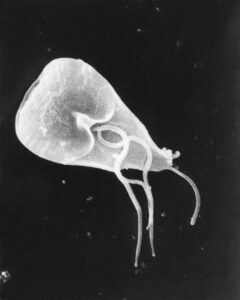Giardia. A little organism, a lot of trouble. Giardia is an intestinal parasite, but not a worm. It is a single celled organism called a Protozoa. Let’s learn some facts about this intestinal parasite which can be so tricky!
Lifecycle-
Giardia exists in two forms. The first is a hardy cyst, which can last in the environment for an extended period of time. Once consumed by a dog, the cyst becomes a trophozoite. This form attaches to the wall of the intestine to feed. The cysts are then shed in the feces and re-enter the environment.
Infection-
Dogs and cats are infected by consuming the cysts. This happens most commonly through ingestion of feces. Cysts can also be consumed by licking or sniffing the rear of an infected dog, or by consuming water infected with cysts. Dogs do seem to more frequently pick up the infection because they spend more time outside and are more prone to eat suspicious things than cats!
Symptoms-
Most commonly giardia causes diarrhea, occasionally with blood. Less commonly vomiting, weight loss, and changes in appetite are seen. The animals who are most susceptible to severe infection are very young puppies or kittens with high trophozoite burden, or immunocompromised dogs. Many animals, especially healthy adults, are completely asymptomatic!
Diagnosis-
A fecal sample is needed to diagnose giardia. The fecal sample is spun in a centrifuge with a fecal float solution, and the sample is examined under a microscope. Even so, it takes a practiced eye to see the very tiny cysts that are shed in the fecal sample. Occasionally an antigen test (looking for specific proteins on the giardia organism) is used to confirm a positive result. All of this testing has some limitations. Sometimes the organisms simply aren’t being shed when the fecal sample is checked. This is especially common in dogs with very small amount of trophozoites. If your dog has diarrhea, sometimes the veterinarian will recommend a second stool sample to be checked to ensure the sample is truly free of protozoal parasites. This is especially important for young animals.
Treatment-
Here’s where things get a little complicated. No “approved protocol” exists for giardia. That doesn’t mean we don’t know how to treat it! It just means there is a lot of minor variation between treatment protocols! This means individual veterinarians and veterinary clinics may simply choose different protocols. Most commonly Fenbendazole (Panacur) or metronidazole (Flagyl) are used. Often they are used together!
Prevention-
Cysts are immediately infectious, so picking up feces right away is helpful in preventing transmission. It is also recommended to wipe rear ends and paws after defecation. This prevents self reinfection, and reinfection of housemates. There is no preventative for giardia infection. While routine use of a heartworm preventative will protect your pet from many intestinal parasites, it will not protect against protozoal infections.
Rechecking-
Again, a great deal of variation exists in recommendations for when to recheck. Anywhere from 2-4 weeks is common. I generally like to recommend a 4-6 week recheck in an otherwise healthy patient. That gives the patient’s own immune system some time to kick in and help the infection along!
Can I get Giardia from my pet?-
Humans are susceptible to giardia infection, however, the most common way for humans to be infected is from contaminated water sources. The most common assemblage of the giardia organism is actually different between species. Humans are less susceptible to the canine assemblage, and there is virtually no cross contamination between cats and dogs. However, it’s still important to use good hygiene. Contamination from pets occurs through fecal oral contact- i.e. ingestion of the cysts from the fecal material. Wearing gloves to pick up feces and washing hands after handling feces prevents infection. This is especially concerning for high risk individuals- immunosuppressed, cancer patients, very young, and very old.
Is it true that it’s hard to get rid of Giardia?-
Tricky question. No, it’s actually pretty easy… most of the time. As a pretty common disease, we are constantly treating cases of giardia. Most show very mild (if any) symptoms, respond to the first round of treatment, and clear the infection. Occasionally a persistent infection does seem to develop. These persistent infections will remain (usually in decreasing numbers) through several rounds of treatments and rechecks. Often these patients are asymptomatic despite their persistent infection. Eventually we do get it cleared up. No pet ever keeps their giardia forever, some of them just seem to take longer to respond to the treatment protocol than others. It can be frustrating, but it does happen.









